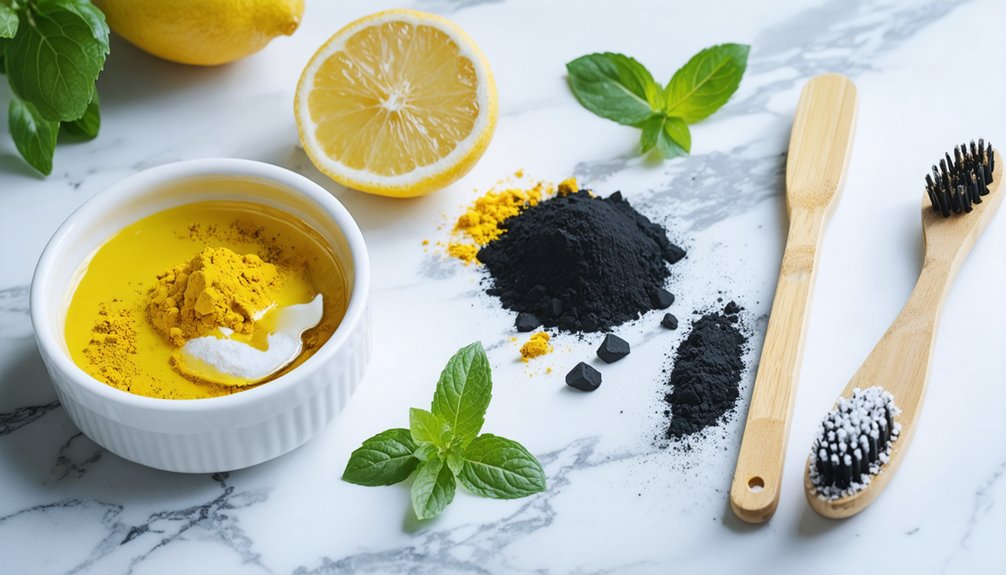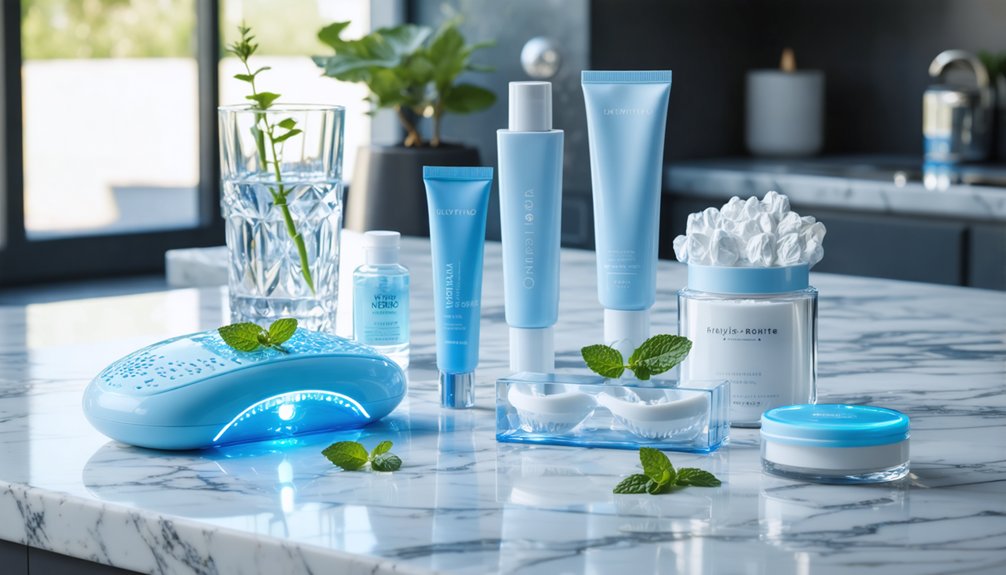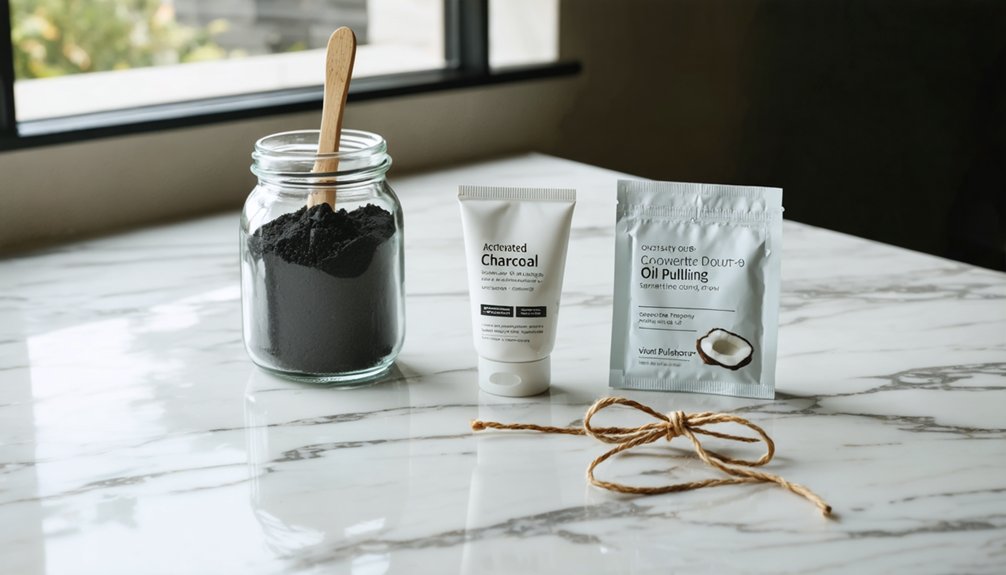You can safely whiten your teeth using gentle, natural methods like oil pulling with coconut oil for 5-20 minutes daily or creating a mild paste with baking soda and water twice weekly. These techniques target surface stains while protecting your enamel. For best results, combine these methods with preventive measures like rinsing after consuming pigmented foods and maintaining proper oral hygiene. Discover how to maximize these natural approaches while safeguarding your dental health.
Key Takeaways
- Oil pulling with coconut oil for 5-20 minutes daily can gently whiten teeth while improving overall oral hygiene.
- Mix baking soda with water to create a gentle whitening paste, using only twice weekly to protect enamel.
- Use diluted hydrogen peroxide (3% or less) mixed with baking soda for a mild whitening effect.
- Incorporate calcium-rich foods and crunchy fruits into your diet to help maintain natural tooth whiteness.
- Rinse with water after consuming staining foods and drinks, using a straw when possible to minimize contact.
Understanding Natural Teeth Whitening Methods
Three key factors shape the effectiveness of natural teeth whitening methods: the active ingredients, their mechanism of action, and safety considerations.
Natural ingredients like baking soda and hydrogen peroxide work primarily by targeting surface stains, though their effectiveness varies considerably compared to professional treatments.
When you’re considering natural whitening methods, it’s essential to understand that while ingredients like activated charcoal and apple cider vinegar can remove surface discoloration, they may cause enamel damage if used improperly.
Oil pulling with coconut oil is another traditional method that can improve oral hygiene while gently whitening teeth.
Professional treatments consistently outperform natural remedies in both speed and results. You’ll achieve the best outcomes by focusing on gentle, ADA-approved methods that won’t compromise your tooth enamel.
Remember that natural whitening requires patience and moderation, as aggressive application can lead to sensitivity and long-term dental issues. Proper evaluation through clinical exams is crucial before starting any whitening regimen to ensure safety and optimal results.
The Science Behind Oil Pulling
While oil pulling has gained popularity as a natural dental care method, scientific evidence supporting its effectiveness remains limited and largely inconclusive. The practice, rooted in Ayurvedic medicine, involves swishing edible oils like coconut or sesame in your mouth to potentially reduce bacteria and soft plaque. The practice traditionally requires 5 to 20 minutes of rinsing to be effective. Recent studies indicate that coconut oil demonstrates superior whitening capabilities compared to other oils.
Studies suggest that oil pulling may decrease salivary bacterial counts, though its impact on plaque and gingival health shows mixed results. While some research indicates it’s comparable to chlorhexidine mouthwash for plaque reduction, claims about teeth whitening and detoxification lack scientific support.
You’ll find various oils recommended for oral health benefits, but their comparative effectiveness remains unstudied. Remember that dental professionals view oil pulling as a supplementary practice rather than a replacement for standard oral hygiene routines.
Safe Use of Baking Soda for Whiter Teeth
To safely whiten your teeth with baking soda, you’ll need to create a paste by mixing one teaspoon of baking soda with enough water to form a smooth consistency.
You should limit applications to twice weekly, using gentle circular motions with a soft-bristled toothbrush for no more than two minutes per session.
While baking soda can effectively remove surface stains, you must avoid excessive scrubbing or prolonged use to protect your tooth enamel from potential wear. Baking soda’s ability to disrupt dental biofilms makes it particularly effective at reducing plaque and gingivitis when used properly. You may begin to see small changes in tooth brightness after about two to three weeks of consistent use.
Mixing Proper Baking Ratios
Safe and effective use of baking soda for teeth whitening depends on proper mixing ratios and application methods.
When combining baking soda with toothpaste, use a conservative approach by dipping your wet toothbrush in a small amount of baking soda before applying your regular toothpaste, or mix about 1/2 to 1 teaspoon of baking soda with a pea-sized amount of toothpaste in a small bowl.
For ideal results, prepare your mixture immediately before use to maintain proper consistency.
While baking soda can effectively remove surface stains through mild abrasion, you’ll want to avoid excessive amounts that could potentially damage your enamel.
Consider using pre-formulated commercial toothpastes containing baking soda, as these products are specifically balanced for safe daily use and ideal whitening effectiveness.
A dental check-up is recommended before starting any whitening routine to ensure your teeth and gums are healthy enough for the treatment.
Visible whitening results typically take 2 to 6 weeks of consistent use with baking soda treatments.
Frequency and Application Tips
Proper timing and application methods determine the success of baking soda teeth whitening. To maximize baking soda benefits while protecting your enamel, limit usage to once or twice weekly.
Mix a small amount with water to create a smooth paste, then apply gently using a soft-bristled toothbrush. The natural sodium bicarbonate compound helps remove surface stains effectively through gentle abrasion. Consistent brushing time of two minutes ensures optimal stain removal.
Watch for signs of enamel sensitivity, which may indicate excessive use. You’ll typically notice initial whitening results within two weeks of consistent application.
Remember to rinse thoroughly after each use and maintain regular fluoride toothpaste brushing on other days.
Never combine baking soda with acidic substances like lemon juice, as this can damage your enamel. If you experience any discomfort or have existing dental conditions, consult your dentist before starting this whitening regimen.
Preventing Enamel Wear
While baking soda’s gentle abrasive properties can effectively whiten teeth, protecting your enamel requires careful attention to technique and consistency.
To maintain enamel strength, mix baking soda with water to form a smooth paste rather than applying it dry. Avoid aggressive scrubbing motions and use light, circular movements with a soft-bristled toothbrush.
If you’ve recently had acid exposure from foods or drinks, wait at least 30 minutes before applying any baking soda mixture. This delay allows your enamel to reharden and reduces the risk of damage.
Limit applications to once or twice per week, as daily use can gradually wear down tooth enamel. Consider alternating between baking soda treatments and regular fluoride toothpaste to support ongoing enamel protection while achieving your desired whitening results.
Prevention Through Diet and Lifestyle
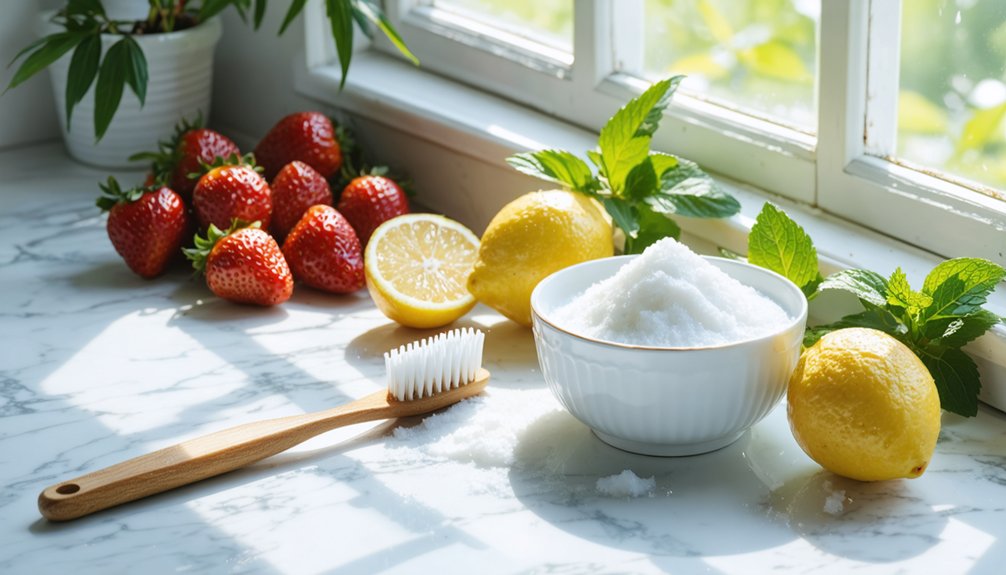
Understanding how your diet and lifestyle choices affect tooth color is essential for maintaining a brighter smile naturally.
You’ll want to limit foods known for staining, such as dark berries, coffee, tea, and red wine. Instead, incorporate protective foods like cheese, yogurt, and crunchy fruits and vegetables that naturally clean teeth and boost saliva production.
To minimize dietary impacts on your teeth, rinse with water after consuming pigmented foods and drinks, and use a straw when possible. Wait 30 minutes before brushing after acidic foods to protect your enamel.
Consider pairing staining foods with calcium-rich options to create a protective barrier. Regular dental hygiene, including twice-daily brushing and daily flossing, combined with these lifestyle choices, will help preserve your teeth’s natural whiteness.
Hydrogen Peroxide: A Gentle Approach
For safe at-home teeth whitening, you’ll need to dilute hydrogen peroxide to a 3% concentration or less to align with ADA guidelines and protect your enamel.
You can create an effective whitening paste by mixing hydrogen peroxide with baking soda until it forms a consistency similar to toothpaste.
The combination leverages hydrogen peroxide’s oxidation properties to break down stains while baking soda provides gentle abrasion, though you should limit application to twice weekly to prevent sensitivity.
Safe Dilution Guidelines
To safely whiten teeth at home with hydrogen peroxide, you’ll need to follow precise dilution guidelines that align with the American Dental Association’s recommendations.
Start with a 3% store-bought solution and make sure you’re not exceeding the safe concentration of 3.5% for home use. Use distilled water or fluoridated mouthwash for accurate dilution ratios and safe measurements.
Limit your application time to 10-15 minutes per session, and don’t continue treatments beyond 14 consecutive days. If you experience sensitivity or gum irritation, reduce exposure time to 5-10 minutes.
Always avoid contact with damaged tissue or exposed roots. Remember that homemade dilutions can be risky, so it’s crucial to measure carefully and consider using ADA-approved products for the most reliable results.
Combining With Baking Soda
Beyond proper dilution techniques, combining hydrogen peroxide with baking soda creates a powerful yet gentle whitening solution for your teeth.
Mix 1 tablespoon of baking soda with 2 tablespoons of hydrogen peroxide until you achieve a smooth, non-gritty paste. The combination works through dual action: hydrogen peroxide chemically breaks down stains beneath the enamel, while baking soda’s mild abrasiveness removes surface discoloration.
Apply the paste using gentle circular motions for 1-2 minutes, then rinse thoroughly. For ideal safety, use 3% hydrogen peroxide and limit applications to a few times weekly.
This method’s effectiveness stems from the complementary actions of both ingredients, providing superior whitening compared to using either component alone. Remember to avoid prolonged contact with teeth, as this could lead to sensitivity or enamel wear.
Protecting Your Enamel While Whitening
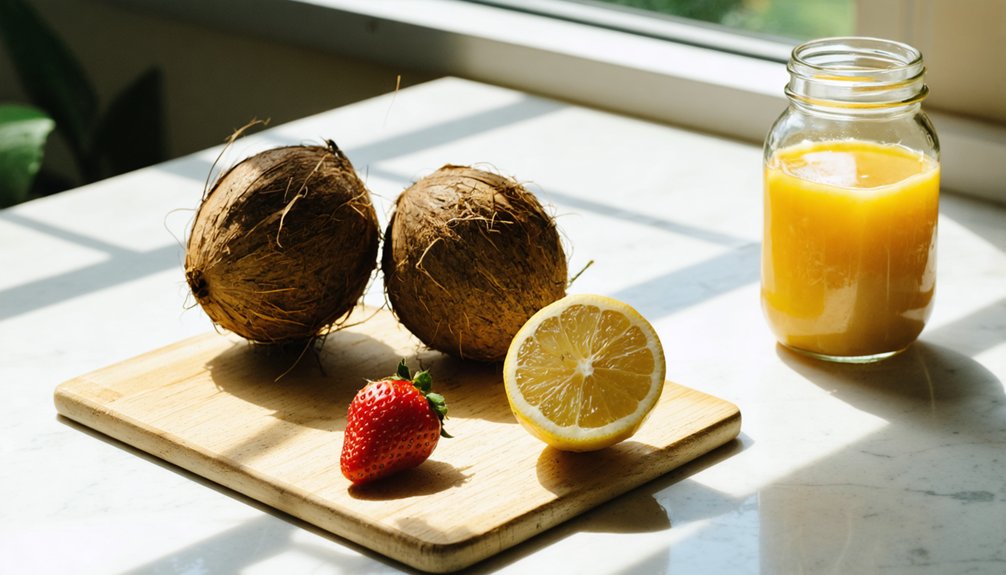
When pursuing natural teeth whitening methods, protecting your tooth enamel becomes essential for maintaining long-term oral health.
To support enamel strengthening while whitening, you’ll need to brush with fluoride toothpaste twice daily and wait at least 30 minutes after consuming acidic foods before brushing. This prevents damage to temporarily softened enamel.
Protect vulnerable enamel by waiting 30 minutes after acidic foods before brushing with fluoride toothpaste to maintain tooth strength.
For sensitivity management, incorporate calcium-rich foods into your diet and limit acidic whitening agents like lemon juice or apple cider vinegar.
When using natural whiteners, dilute them appropriately and don’t apply them directly to teeth. Consider oil pulling with coconut oil as a gentle alternative to abrasive substances.
Most importantly, maintain consistent oral hygiene practices, including daily flossing and adequate hydration to support your saliva’s natural protective functions.
Common Myths About Natural Whitening
Many people mistakenly believe that natural teeth whitening methods can match professional treatments in effectiveness and safety. Common natural misconceptions include using baking soda, coconut oil pulling, or fruit peels as effective alternatives to professional whitening.
However, scientific evidence doesn’t support these claims. While natural remedies might temporarily remove surface stains, they can’t address deeper discoloration or provide lasting results.
More concerning is that unsupervised use of natural whitening methods can damage your enamel and increase sensitivity. Substances like lemon juice and charcoal may actually harm your teeth over time.
Remember that intrinsic stains, especially those from medications or genetics, won’t respond to natural treatments. For safe, predictable results, consult your dental professional, who can recommend appropriate whitening options based on your specific needs.
Combining Natural Methods Safely
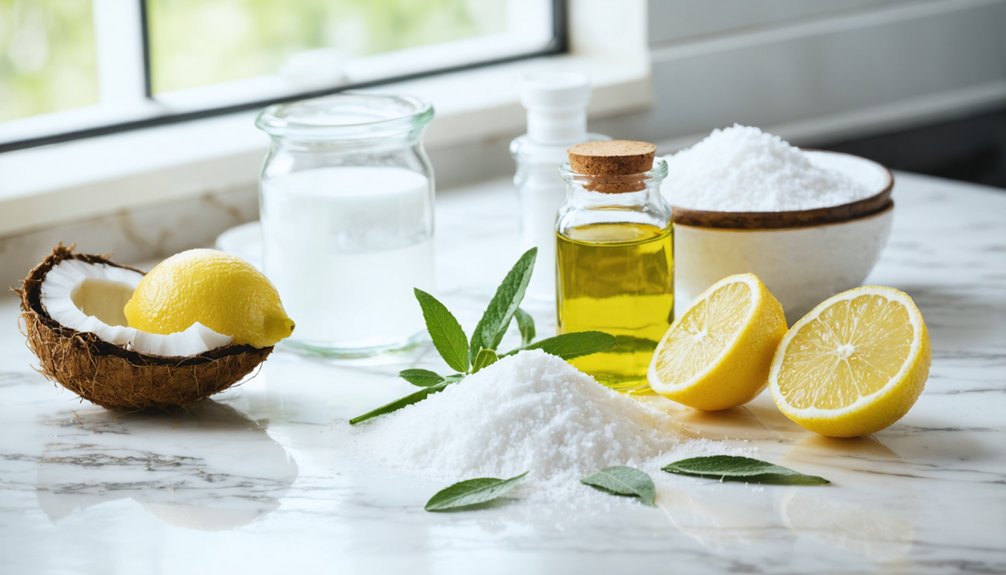
Although natural teeth whitening methods can be effective individually, combining them requires a strategic approach to maintain safety and maximize results.
When exploring natural combinations, you’ll want to alternate between different methods rather than using multiple treatments simultaneously. For instance, you can use activated charcoal one day and baking soda the next, allowing time between applications to protect your enamel.
To implement safety precautions, don’t combine acidic ingredients like strawberries with abrasive substances such as charcoal.
Instead, complement your natural whitening routine with preventive measures like oil pulling or whitening toothpaste. Always maintain proper pH balance and consult your dentist before starting any combination of treatments.
Remember that moderation is key – even natural methods can cause sensitivity or enamel damage if overused.
When to Seek Professional Help
Understanding the limitations of natural teeth whitening remedies can help you recognize when professional intervention becomes necessary. If you’re experiencing persistent discoloration from aging, medications, or genetic factors, these issues often require professional options beyond natural solutions.
Particularly concerning are grayish or brownish stains that don’t respond to home treatments.
You’ll need to consult a dentist if you have sensitive teeth, gum problems, or active decay, as natural whitening methods could worsen these conditions.
Additionally, if you’re seeking rapid results or have discoloration causes linked to tetracycline use or excessive fluoride exposure, professional treatment offers more predictable outcomes.
Remember that natural remedies won’t affect dental work like crowns or veneers, and children under 16, pregnant women, and nursing mothers should avoid whitening treatments altogether.
Frequently Asked Questions
Can Natural Whitening Methods Help With Fluorosis Stains on Teeth?
Natural alternatives won’t effectively treat deep fluorosis stains since they’re intrinsic. While you can use baking soda for surface stains, you’ll need professional fluorosis treatment for significant improvement.
How Long Should You Wait After Whitening Before Drinking Hot Beverages?
Over 80% of patients experience teeth sensitivity after whitening. You’ll need to wait 48 hours before drinking hot beverages to protect your enamel and prevent staining while your teeth rehydrate and recover.
Do Medications Affect How Well Natural Teeth Whitening Methods Work?
Yes, medication interactions can greatly impact whitening efficacy. Your medications might cause intrinsic stains, alter oral pH, or weaken enamel, making natural whitening methods less effective or potentially risky.
Can Breastfeeding Mothers Safely Use Natural Teeth Whitening Remedies?
You can use gentle whitening agents like low-concentration toothpaste while following safety precautions, but breastfeeding guidelines suggest waiting for intensive treatments until after weaning for maximum peace of mind.
Does Swimming in Chlorinated Pools Affect Natural Teeth Whitening Results?
While chlorine effects from pools don’t directly impact whitening results, proper pool maintenance levels can minimize potential enamel sensitivity. You’ll want to stay hydrated and maintain regular dental care.
References
- https://pmc.ncbi.nlm.nih.gov/articles/PMC4058574/
- https://www.ada.org/resources/ada-library/oral-health-topics/whitening
- https://www.healthline.com/nutrition/whiten-teeth-naturally
- https://pmc.ncbi.nlm.nih.gov/articles/PMC10024105/
- https://www.thetopekadentistry.com/blog/natural-teeth-whitening-methods-work/47541
- https://www.urmc.rochester.edu/news/publications/health-matters/diy-teeth-whitening-too-good-to-be-true
- https://www.sunbritedental.com/dental-services/cosmetic/blog/do-natural-teeth-whitening-remedies-really-work
- https://newsnetwork.mayoclinic.org/discussion/mayo-clinic-q-and-a-many-safe-choices-available-to-help-whiten-teeth/
- https://libertydentalplc.com/why-you-should-avoid-natural-teeth-whitening-methods/
- https://pmc.ncbi.nlm.nih.gov/articles/PMC9602184/
